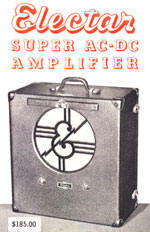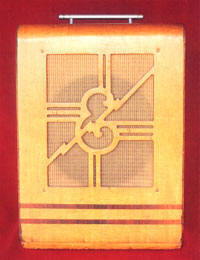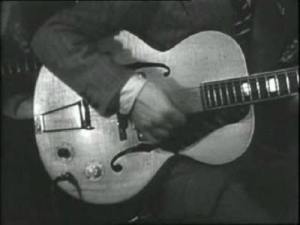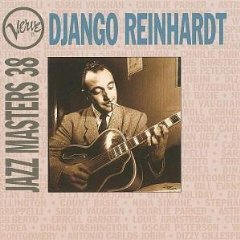Django’s Epiphone Guitar
Django 1946 playing Electric (before USA Tour) There is a Film sequence but it is the actual un-retouched or dubbed version that appeared in a French Newsreel in May, 1946. It shows Django playing at the “El Rodeo Club” with Michel de Villers on Clarinet, Eugène Vées Guitar & André Jourdan Drums. The significant feature of this Film is that it proves Django played an Electric Guitar BEFORE he went to America. It is almost certain Django did not own this Guitar & it probably belonged to Vées. Django’s over-dubbed playing does not appear on any Issued Record and was almost certainly recorded at the “El Rodeo Club” Gig.
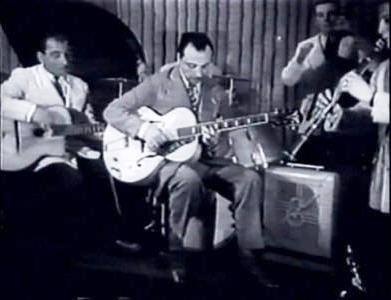
Django with Epiphone & Electar Amplifier on 29th May 1946 which challenges the Joe Sinacore New York Epi Factory Story somewhat.
Grappelli – Django 1st heard an Electric Guitar in ’46 or ’47; I think it was at the Hackney Empire. Somebody brought in the Guitar and it made a terrible noise – in those days Electric Guitars didn’t sound as good as they do now. But Django was so impressed because at last he could play loudly. He played with such volume that I had to ask him to turn it down as it was drowning all of us. He was like a child with a new toy. Of course, to be fair, he didn’t know how to handle it. We’d heard Charlie Christian & although he would never play like Django, if you know what I mean – the Electric Guitar being easier than Acoustic – Charlie Christian was a master of the Electric Guitar, Django was born to play Acoustic Guitar and the richness of Django was in his Chords and he could never achieve the same dynamic effect that he could from his Acoustic Guitar. He never succeeded to play Electric and in my opinion he never was a good Electric Guitarist.
Steph’s statement is clearly wrong and the Film clip of Django playing the white (Blonde) Electric is from May 1946 before he went to America. I also have a photo of him with some crude Amplification on his Guitar from 1945. – Roger S Baxter.
The Quintette played the Hackney Empire in August 1939 so Roger may be right
About the tracks recorded throughout 1947 at the Radio Diffusion Francaise Studios Montmartre. These recordings are so completely amazing that I wonder how they came about. By & by I begin to realise the value of those particular Recordings. If you take a look on what Django recorded in 1-single day, and when you listen to those recordings, it absolutely blows your mind. I guess those recordings were played on the air, and I’m not quite sure if the tunes available are recorded by some amateur buff, or if they were recorded during airplay & those matrices were used for the records. I’m also very fascinated by the sound of the Electric Guitar Django used on those Occasions. (It’s actually my favourites among his Electric period.) Claus
Most people prefer the lyrical subtlety of Django’s acoustic instrument as opposed to the harsher Electric sound that he as produced on the Electric Guitar with his BeBop developments – but as Django did not speak English he could on only watch listen & learn and then apply – the likes of Johnny Smith & Les Paul were already adept at dealing with pickups, controls & amplifiers which was all new to our Gypsy Genius. For my part the best Recordings in this period are from the Selmer Maccaferri Acoustic guitar fitted with the Stimer pickup where there is only 1-Control and with this familiar instrument and the added Amplification of the day he achieved a more fluid Improvisational skill than he did with the American Archtops. Many American Electric Guitarists owe a debt to Django for raising the Soloists standard.
But he seemed lost within the Ellington Band 46 recordings and they with him as he new nothing of reading scores and whilst he made brave attempts with the Gibson ES-300 (and or the Epiphone) as a soloist he also behaved in his normal manner with rhythmic support which almost drowns the bands riff on ‘Honeysuckle Rose’. Remember his amp would have been punching out front and there were few sound system engineers abroad in those days and certainly no foldback and probably only one Stage Mic.
The Epiphone Brand was named after Epimanondas Stathopoulo, President of the Company and one of the sons of the Company founder, Anastasios Stathopoulo. Anastasios was a Greek Immigrant & Violin maker who came to America in the late 1800‘s. In 1923 Epi came up with a new name for his Company based on a combination of his nickname & the Greek word for sound: “Epiphone.” 1924 saw the release of the Epiphone Recording Banjo Series. The popular Artist, Bandmaster, Concert, Deluxe & Emperor Banjo models soon followed. By 1928 Epiphone had bought out other Banjo Manufacturers to keep up with their own expanding Business and had changed the Company name to the Epiphone Banjo Company. The 1st Production of Epiphone Guitars coincided with the Stock Market Crash of 1929, when the Banjo boom also went bust. Epiphone Recording Guitars of spruce & laminated maple helped take up the slack for the declining Banjo demand. Epiphone History
1936 saw the Super AC-DC featuring the stylistic E-Logo. The Cab was covered with Keratol, a Vinyl like finish material & had “Detacho” back & front Panels. This Electar Amp was rated at 30-Watts with a 12” Speaker. The Catalogue stated, “This Amplifier is Custom Built and is the ultimate for AC-DC Operation. The tremendous volume is sufficient to fill the Largest Hall and is used in large Orchestras.” The Special, introduced in 1937 is quickly followed by the Coronet & the Century.
As the Electric Guitar took over on the Bandstand, the Century became a favoured Amp among Guitarists. An extremely striking Furniture Grade Cabinet that employed Figured Maple came complete with a Metal Handle located on the top. With rear mountedControls, it was perfect for Orchestra work where the Guitarist placed the Amp in front of his Music Stand.
The Century, with its elegant good looks, became an instant success for Epiphone & could be seen on Stages around the World. Players such as Al Hendrickson of the Artie Shaw Band, Lloyd Gillson with Sammy Kaye, Harold Aloma with the Tommy Dorsey Band, Al Caiola and George Van Eps, Father of the 7-String Guitar, were all endorsing the Century.
Next in the line-up was the Zephyr. Introduced in 1939, this Amp featured an angled back so that better projection could be achieved. At 22½” Tall, the Zephyr was tailored to fit into the existing look that Dance Bands were using at that time. The Controls had now been moved to the top of the amp making it far more convenient for the Player to make adjustments to the Dials. The back Panel was cut with slots to allow rear Speaker dispersion & better Ventilation for the Valves. A higher powered Dreadnought version of the Zephyr was also available.
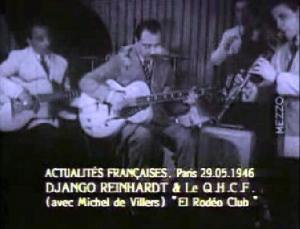
The most famous player to use an Epiphone amplifier would have to be Django Reinhardt, seen above. This photo, taken from rare Film Footage, shows Django playing a natural Epiphone Zephyr through an Electar Zephyr Dreadnought. During his only trip to the United States in October 1946, Django is claimed to have acquired the Dreadnaught while visiting the Epiphone Factory at West 14th Street in New York City. Reinhardt’s immortal works are well known, but it is his Electric recordings created towards the end of his life which are the rarest. As the premier Gypsy Jazz guitarist, Django has influenced players throughout the world with his blistering technique & haunting melodies. Chet Atkins, Joe Pass, BB King, John McLaughlin, Larry Coryell, Les Paul, Charlie Christian & Wes Montgomery all sight Reinhardt as a major influence.
I’ve spent a lot of time trying to definitely establish when Django 1st played the Electric/Amplified Guitar and I am now absolutely sure it was before his trip to America and equally sure it was on 29th May 1946. These are the main reasons:-
 There is a brief article in the October,1945 issue of BMG which states:- “Django Reinhardt definitely uses an Electric Guitar these days. Details came from American Banjoist Freddy Morgan who was compére for a Reinhardt Show given under USO auspices recently at Nice, France.” There is an accompanying photo which shows, amongst others, Django & Freddy Morgan at that Concert.
There is a brief article in the October,1945 issue of BMG which states:- “Django Reinhardt definitely uses an Electric Guitar these days. Details came from American Banjoist Freddy Morgan who was compére for a Reinhardt Show given under USO auspices recently at Nice, France.” There is an accompanying photo which shows, amongst others, Django & Freddy Morgan at that Concert. - In an Interview at the January,1946 Recording Sessions in London, Django is asked for his views on “the Electrically-amplified Guitar”. His response is – “Yes! he played the Electric Guitar for a few weeks, but did not like it as it would not produce what he described as the “human tone“”.
- Photos were taken in late 1945 and show Django with some crude Amplification on his Selmer. You can see the Electric Chord hanging from his Guitar (perhaps using some kind of Contact Mic given to him by a US serviceman) & the Amplifier on the Chair in front of him. Item 3 brings into question the validity of Fred Sharp‘s claim that the Epiphone he had actually belonged to Django This clip is the only time we ever see Django playing an Epiphone and it was BEFORE America so clearly it was not bought whilst he was there as claimed. All the photos of the American trip show him playing a Gibson ES-300. There is a photo of Django and Joseph amongst a group of Gypsies taken around May, 1946 and behind them is Eugene Vees who appears to be holding the white Epiphone. I doubt whether Django ever owned such a Guitar and he had just borrowed it to play it at the “El Rodeo” gig where, interestingly, Eugene Vees was on Rhythm. It was probably owned by Vees.
- This clip of Django playing a ‘white’ or blonde Epiphone at the “El Rodeo Club” is from a French Newsreel Broadcast at the end of May, 1946 just before he left for the USA :-
Also, how probable is it that Django would own a Guitar in 1946, never play it in Public again yet keep it until he died? He had no real interest in guitars per se and discarded or gave away anything that he no longer played. Scot Wise told me Fred was always a bit vague about the Epiphone when he asked him about it and then it suddenly “disappeared”. There is a brief discussion about it here:- http://www.djangobooks.com/forum/viewtopic.php?f=11&t=4024 . It is, of course, possible that it was the Guitar Django played at the “El Rodeo” gig which Vees or whoever owned it subsequently gave to Babik Reinhardt but the connection is very tenuous & not as Fred Sharp claimed. That may well not be Fred’s fault. It is quite possible Babik Reinhardt “embroidered” the story somewhat. Roger S Baxter
(Picture Epiphone Zephyr Deluxe 1945-47 the Frequensator Tailpiece is quite different from that shown on the Film Clip.)
The Clip of Django playing the ‘White’ (Natural) Epiphone comes from an item about Gypsies which is part of quite a long Newsreel sequence dated May,1946 so I am pretty certain the date is correct. It is part of a library of French Newsreel and should be accurate. The footage with the date caption is a modification of the original sequence and I would be sceptical if this were the only date reference we had.
As I said, all the photos we have of Django in concert in America show him playing the Gibson. He is also posing with a Gibson (ES300) the photo with Paul Whiteman which was taken at the Cafe Society Uptown gig that he did after the Ellington Concert Tour was over. As you say there are photos of him posing with Fred Guy’s guitar and playing some of Harry Volpe’s Gretsch’s but nothing involving an Epiphone. I am sure if he had owned one when he was in the USA, we would have seen him playing somewhere. My understanding is that he sold or gave away the Gibson & also the Selmer that Delaunay brought over for him (after it was repaired). Since he went to America without bothering to take a guitar, I would have thought it highly unlikely that he would bother to go home with one.
If you look at the photo and this video clip from around 1955
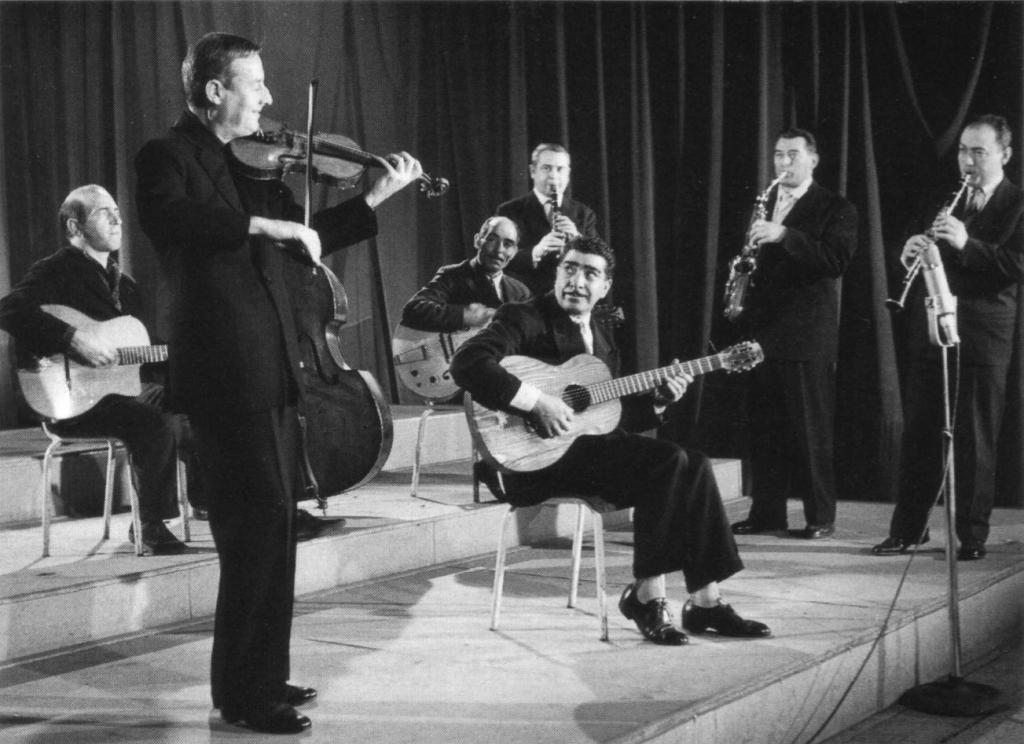
Steph, Joseph, Eugene Vees on Epi and Ekyan,
the unamplified guitar that Eugene Vees is playing looks very much like the Epiphone Django plays in the 1946 Footage. If so, that would fit in with my belief that it is more likely Vees owned the Epiphone. Perhaps he subsequently gave it to Babik who in turn gave it to Fred Sharp. On the other hand, perhaps it had nothing whatsoever to do with Django. Also, remember Babik was very young when Django died and most of the information he (Babik) would have about Django would be 2nd-hand. We will never know for sure but Fred’s story does not hang together.
Stephane Grappelli Joseph Reinhardt Emmanual Soudieux Henry Crolla Eugene Vees Gerard Leveque Hubert Rostaing Andre Ekyan Minor Swing
Faraday’s Law & the Electric Guitar: The Electric Guitar utilises the concept of Faraday’s Law as well as other concepts related to Magnetism. All Electric Guitars have a device called a Pick-up which is placed underneath the Magnetic Guitar strings. These Pick-ups are Wire coils with an Average of 4,000 to 7,000 turns! When the magnetised String is plucked, it vibrates like a little Magnet and changes the magnetic Flux going through the Coil, inducing an EMF through the Coil, and producing an Electric Signal which can be Amplified.
By the end of the 1920s the guitar was more popular than ever. But, because it could not compete in Volume with the Drums and Horns of the Jazz Age, it was Limited on the Bandstand to providing a pulse. Microphones were in wide use, and amplification was an accepted technology, particularly in entertainment. PA Units with Amps & Speakers were used to add volume to Vocal Performances, Phonographs & Radios. Many Guitar Players had stepped up to the Microphone and had their playing Amplified. But this Setup had Limitations, so Guitarists looked at ways to combine Microphone & Amplification Technologies specifically for Guitar. They experimented with telephone Mouthpieces, Microphones, Phonograph tone arms, and reverse-wired speaker Coils. Alvino Rey, who became one of the 1st stars of Electric Guitar, recalled that during this period more than one person was experimenting with rudimentary Electromagnetic Units.
In this clearly defined picture the control Knobs are different colours show plastic numeral dials and the Jack Socket is on the bottom of the rear bout
Django & Amplified Guitar: Django left his prized Oval Hole Selmer Guitar in his native France; it is claimed he visited the New York City Factory of Epiphone and chose an natural-finished Zephyr model Guitar, almost identical to the guitar shown in these pictures. Django’s guitar had additional neck binding and block mother of pearl inlays probably the deluxe version; the New York pickups and other features were unchanged. The control knobs are in slightly different locations as is the Jack Socket. The Tailpiece indicates variations. But every image of Django in the States showed him with borrowed Guitars and he played the Concerts with the Gibson ES-300. Verve Album – Django poses with Fred Guy’s Swedish Acoustic Rhythm Guitar – the last 3-Tracks offer a rare glimpse into Django’s experimentation with the Electric Guitar & Bebop.

